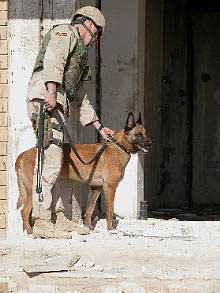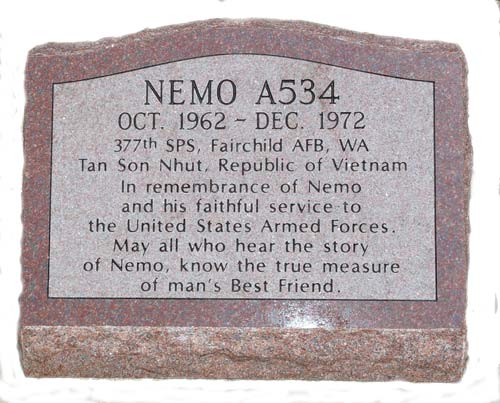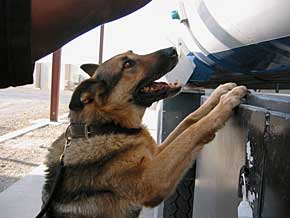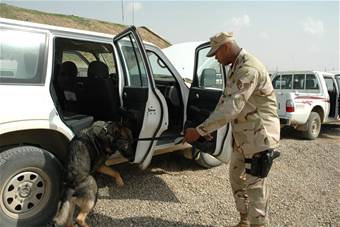Military
dogs help defend Iraq 11/28/2003
- - TALLIL AIR BASE, Iraq (AFPN) - Hiding behind
mounds of dirt or anything else his handler could find, Tino sat and
waited for an intruder to breach the base’s fence on his random
listening and observation post. Suddenly, the military
working dog’s ears, eyes and nose zeroed in on two men as they entered
the base’s perimeter. As the men closed in, Tino stood up, fluffing up
his hair and tail to make his presence known. (Story re-printed courtesy of AFNEWS - Air Force Print News http://www.af.mil/news/ )
K-9 partners
operate on vigilance, trust 03/25/03 - OPERATION IRAQI FREEDOM (AFPN) -- At base gates, military working dogs and handlers are doing their part in the war with Iraq while guarding against the threat of terrorism. These threats mean there are more reasons than ever to suspect that America's enemies will target its most valuable resources with explosives or hazardous materials. Air Force K-9 teams are on guard to detect such attempts. "We ensure everything that comes on the installation is safe and doesn't jeopardize our people and our mission here," said Tech. Sgt. Chris Goll, the kennelmaster at a forward location. Goll is deployed from the 35th Security Forces Squadron at Misawa Air Base, Japan. Dogs and handlers deploy together, usually for 135 to 140 days. This predictable process was disrupted by the build-up and military action to rid Iraq of weapons of mass destruction and Saddam Hussein's regime. All the while, memories of terrorist strikes against America on Sept. 11, 2001, remain. "The whole culture now after 9-11 in force protection is all about looking for stuff coming on the base," Goll said. Guarding against this danger has become a constant job. "We're the first ... line of defense. It's very important that our guys are vigilant and making sure that these dogs are working hard because sometimes they get tired. It's up to our handlers to keep them going. "A good handler -- and all of our handlers are good -- can motivate a dog to work past (its) threshold. There are so many ways to hide things in vehicles; a trained eye can only find so much. That's the biggest thing (the dogs) provide." The two primary breeds of working dogs used in the Air Force are German shepherds and Belgian malinois which are similar in appearance, Goll said. Handlers have to take precautions to keep the dogs working at peak performance in temperatures that can reach 120 degrees. The dogs work inside climate-controlled search areas whenever possible, Goll said. Patrols, however, may take them out in the heat of the day. "If it gets too hot we have cool vests that go on the dog," Goll said. Other (preventative) measures include swapping out a dog's work schedule from days to nights. "This will shorten our week so they get more time to rest. But there's some days you just have to (work) through it." The importance of the K-9's mission was not always apparent to those outside the law-enforcement community before 9-11, Goll said. "They knew we were there if they needed us. Now you'd be hard-pressed to find anyone -- the commanders, the senior enlisted leadership -- who aren't focused on the dog's mission." Military working-dog handlers are a special breed themselves, Goll said. "It is important that you like animals, because you're with these dogs a lot. It's a friendship that grows out of trust for each other. The dog has to come to trust you as well as you trust the dog. Once that happens you've got a real good team." Staff Sgt Sloan Kalina graduated from the Department of Defense military working-dog school at Lackland Air Force Base, Texas, in August after nine years in security forces investigations. Deployed from Kirtland AFB, N.M., he is teamed with Torro, a Belgian malinois. "It's a great responsibility protecting all these people and all these assets," Kalina said. "Planes don't fly if these people aren't safe." Kalina said Torro has alerted twice on suspicious scents. The first was on his third day on the job. Kalina said his training told him what to do next. "You just pull (the dog) out of there, get everybody out of the location and let (the explosive ordnance disposal airmen) come and do their job." Although nothing was found on either alert, Kalina said he would "rather not have something there than let something through that was." The staff sergeant said he trusts the dog with his own life every day that he sends him in after potentially deadly materials. "I've got all the faith in the world in him. He'll find it if it's there." (Story re-printed courtesy of AFNEWS - Air Force Print News http://www.af.mil/news/ )
Four
defenders work like dogs 02/04/03 - OPERATION ENDURING FREEDOM (AFPN) -- Working like a dog. This simile relates to someone who works tirelessly throughout a busy day. For four exclusive members at the 380th Air Expeditionary Wing, "working like a dog" is more than a simile. It is their daily life. Arkie, Tasja, Athos and Dutchy are part of the military working dog team at a forward-deployed location. These fabulous four put forth all their effort to ensure base residents sleep safer at night, protecting them from any explosive that may enter the base. "The dogs go through extensive training before getting deployed here," said Staff Sgt. Damion Tineo, part of the 380th Expeditionary Security Forces Squadron K-9 patrol who is teamed up with Tasja. "Dogs are getting deployed now more than ever before," he said. A three-month deployment is nothing new to these four dogs. Each of them has been in the area at least once before. Arkie, who is designated as the veteran of the group, is currently on his fourth desert deployment according to his partner, Staff Sgt. Louis Smith, 380 ESFS K-9 patrol. The only German shepherd here, Arkie is the oldest dog of the four. The military working dogs are treated in the same manner that their trainers are when arriving in theater. "When the dogs arrive here, they have to get adjusted to the new environment as we do," said Staff Sgt. Robert Odom, a handler with the 380th ESFS K-9 patrol who is teamed up with Dutchy. "They are just like people, (and) they get stressed out too," he said. Their days here include lengthy hours and rotating shifts at the vehicle search area. It is here where people can see these base members examine vehicles for any suspicious materials. "Their instincts are 10 times better than ours," said Tineo. "They are awesome with their senses." Training never stops for the dogs while they are here. On days when they are not at the vehicle search area, they are either training in various areas such as patrol and protection, resting or just being dogs. "We can't have them work all the time because it is not fair to them," said Odom. "We let them relax and make sure they are not always cooped up by coming in on our off days and letting them out to be dogs." Their scheduled training revolves around two days of patrol exercises and two days of protection exercises. Done in various buildings throughout the base and on the flightline, the dogs participate in exercises where they are required to complete certain tasks. After accomplishing the required tasks, they get rewards that range from praise to squeaky toys. Although these dogs appear approachable, these selective four are not family pets by any means and are not to be petted without permission by their trainers. "A lot of people do not realize that these dogs are trained to attack," said Staff Sgt. Patrick Smith, who is teamed up with Athos. "These dogs are meant to be petted by their handlers, and if strange people just come up and pet our dogs ... they may lose their edge, and we are not going to let that happen." Athos, Arkie, Dutchy and Tasja show base residents what it is really like to work like a dog.
3/10/2006 - KIRKUK
AIR BASE, Iraq (AFPN) -- “Get 'em!” |





